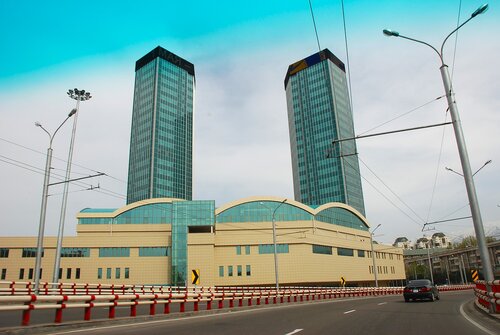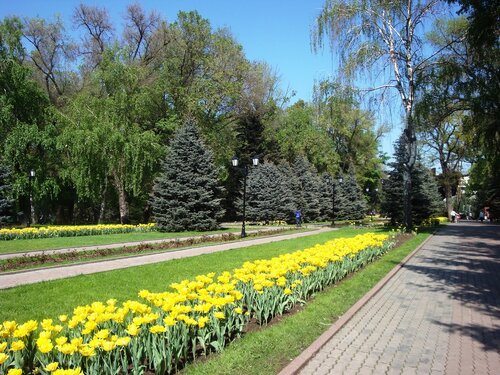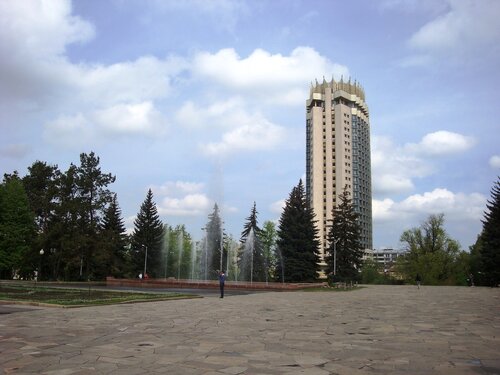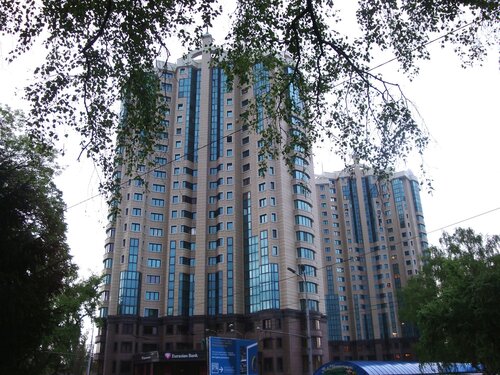
среда, 26 мая 2010 г.
Almaty 2020 general plan

среда, 19 мая 2010 г.
History of Almaty

Background Information
Almaty is situated in the center of the Eurasian continent on the southeast of the Republic of Kazakhstan in longitude 77 East and 43 latitude North on the bottom of Zailiisky Alatau – the most northern mountain range of TyanShan. Gagri and Vladivostok are situated on the same parallel.
The Almaty climate is sharply continental with significant temperature fluctuations during the year and the day. At the 500-meter height you can see city streets directed to the north, steppes, hottest Prikaskelenskiye Muyunkumy. You can feel glaciers’ breath in the residential areas on the south while being at the 1500-1700 meter height over the sea level in Medeu and Kamenskiy Plato tracts.
Flora and fauna of Zailisky Alatau are impressively diverse and luxuriant. Almaty suburbs are considered to be the part of the Ile-Alatauski national park that is hosting natural reservations and wildlife sanctuaries. Most rare kinds of birds and animals that live on the protected territories are recorded in the Red Book of Kazakhstan, including a snow leopard (irbis) that is now depicted on the Almaty emblem.
At the bottom of the mountains tobacco, melon, grain and grapes plantations are replaced by orchards and berry fields. Over 8 thousand hectares of the city territories are cultivated and planted with gardens, parks, squares and boulevards. This is the place of origin of the Almatinskiy aport.
The city area is over 170 square meters and situated between the Bolshaya and Malaya rivers and  their inflows. City rivers and lakes are the main water supply sources for Almaty.
their inflows. City rivers and lakes are the main water supply sources for Almaty.
ALMATY EVOLUTION STAGES
During X-IX B.C. in the bronze era the first farmers and cattle-breeders established settlements on the territory of Almaty . It is evidenced by Terenkary and Butakty settlements located on the territory of the city. Archaeologists found there ceramics, instruments and products made of stone, bone and metal.
VII B.C. – beginning of the Common Era. During the saki’s period, Almaty was chosen for residence by saki tribes and later uisun tribes. The evidences of these times are numerous burial tumuli and ancient settlements, especially giant burial mounds of saki tsars. The most famous archaeological finds are the Golden man from the Issyk tumulus, Zhalaulinsky treasure, Kargaky diadem, Semirechinskaya arts bronze (boilers, lamps and alters). During the period of saki and usun governance, Almaty became the early education center.
VIII – X. The next stage of Almaty evolution is attributed to the Middle Ages and characterized by the city culture development, transfer to the settled way of living, farming and handicraft development, emerging a number of towns and cities on the territory of Semirechye . Archeological diggings on the territories of ancient settlements resulted in numerous ceramic, metal and bone finds.
X – XIV. Settlements situated on the territory of the, so called, Big Almaty, became the part of trade routes of the Great Silk Way . At that time, Almaty turned out one of the trade, craft and agricultural centers on the Great Silk Way and possessed a mint. One of the evidences of this mint was found on the territory of the existing Border Guards Academy . They found two silver coins of XIII (dirkhems). Experts testify that the city was first mentioned as Almatu in old books in the thirteenth century.
XV - XVIII The city was on the way to degradation as trade activities were condensing on this part of the Great Silk Way . Notwithstanding, this period was saturated with very important political events that had significant impact on the history of Almaty and Kazakhstan as a whole. It was a period of crucial ethnic and political transformations and forming of the Zetysu original culture. The Kazakh state and nation were founded here, close to Almaty.
These lands also witnessed the tragic developments related to the Jungar intervention and rigorous efforts of the Kazakh to protect their land and preserve independence. In 1730 the Kazakh defeated the Jungar in the Anyrakay mountains 70 km to north-west from Almaty. It was a critical moment of the Patriotic War between Kazakhs and Jungars.
4 February 1854 . The new history of the city started from strengthening the Russian piedmont fort “Verniy” nearby the Zailiysky Alatau mountain range between Bolshaya and Malaya Almanka.
The construction of the Verniy Fort was almost finished by autumn 1854. It was a fenced pentagon and one of its sides was built along the Malaya Almatinka. Later, wood fence was replaced with the wall of brick with embrasures. Main facilities were erected around the big square for training and parading.

 On July 1 1855 the first displaced Kazakh appeared in Verniy. Since 1856, Verniy started accepting Russian peasants. They founded the Bolshaya Almatinskaya Stanitsa (Cossack village) nearby the fortification. The inflow of migrants was increasing and led to construction of the Malaya Almatinskaya Statitsa and Tatarskaya (Tashkentskaya) sloboda. It was the place of settlement for Tatar mechants and craftsmen. In May 1859 the number of population totaled 5,000 persons. Construction activities were managed by engineer L. Aleksandrovskiy and military engineer T. Gumnitskiy.
On July 1 1855 the first displaced Kazakh appeared in Verniy. Since 1856, Verniy started accepting Russian peasants. They founded the Bolshaya Almatinskaya Stanitsa (Cossack village) nearby the fortification. The inflow of migrants was increasing and led to construction of the Malaya Almatinskaya Statitsa and Tatarskaya (Tashkentskaya) sloboda. It was the place of settlement for Tatar mechants and craftsmen. In May 1859 the number of population totaled 5,000 persons. Construction activities were managed by engineer L. Aleksandrovskiy and military engineer T. Gumnitskiy.
On 11 April 1867 the Verniy Fort was transformed into the town and called Almatinsk. However, the population did not like the new name of the town and soon the town was re-named as Verniy as reported by the government Steppe Commission. Such a transformation of the fortification into the town is justified by the Reform of 1867-1868. Verniy became the center of the Vernenskiy uezd and Semirechenskaya oblast. G.A. Kolpakovskiy was the first governor of the Semirechenskaya oblast.
The first City Plan was elaborated by N. Krishtanovskiy. He offered the following parameters of the city: on the south along Almatinka was 2 km, and on the west was 3 km. He also offered to supply the city with hay, horse and green markets and lay out four parks.
The new city area was divided into residential parts, and the latter – into districts. Three categories of the city buildings were distinguished. Buildings of the first and second categories were two-storied or, at least, one-storied constructions with the high semi-basement. Buildings of categories I and II were erected around and in the center of the city, others – on the outskirts. It was quite possible to purchase land and build a house.
The Gostinodvornaya square was a composition center of the city. Today, there is the Almaty center there. Main administrative and public buildings were situated around the Municipal park (today, this is the Park named after 28 Panfilof warriors).
G.N. Serebryanikov (1839-1883) was the first city architect.
On 28 May 1887 at 4 am the earthquake almost totally destroyed Verniy for 11-12 minutes . Brick buildings were mostly damaged.
On 1 June 1887 the military governor of the Semirechinskaya oblast approved the order “Due to the revealed unreliability of brick constructions in case of earthquakes, it is hereby ordered to build wooden houses only” («Semirechinskiye vedomosti », №91, 1 June 1887 ).
To investigate earthquake consequences and develop an adequate plan of action in case of emergency, I.V.Mushketov set up a special post-earthquake research commission in Semirechye.

 The earthquake deteriorated the image of the city. As a result, people were inclined to build up one-storied construction made of wood or adobe. Significant contribution to the reconstruction and improvement of the city image was made by A.P.Zenkov. He was a military engineer and architect. He was the first to elaborate and deploy the seismic construction standards (for example, Cathedral).
The earthquake deteriorated the image of the city. As a result, people were inclined to build up one-storied construction made of wood or adobe. Significant contribution to the reconstruction and improvement of the city image was made by A.P.Zenkov. He was a military engineer and architect. He was the first to elaborate and deploy the seismic construction standards (for example, Cathedral).
The earthquake of 1910 was the bright evidence of appropriateness of these standards. Greening of the city was a great achievement. It was the merit of the city governance and brothers Eduard and Otto Baums. Otto Baum was a silviculturist, since 1883 he was in charge of the Public garden (Gorkiy park), in 1880 he laid out the grove that is nowadays is known as the Baum’s grove.
In the report of 1909 “ Russia . Complete geographic description of our motherland” edited by Semenov-Tan-Shanskiy, there is an interesting description of Verniy: “Verniy is a concentration of all the government institutions including those managed by the military governor. This is the post of duty of Turkestanskiy and Tashkentskiy bishop. The population of the city is 37, 000 people (26 000 – Russian, the rest – taranchi, dungane, sarty, Tatar, Kyrgyz; in Verniy there are 2 100 buildings, 9 churches, 4 mosques, 18 educational institutions, a small regional museum, 66 plants and factories with 313 working places. Municipal incomes total 119.515 rubles, expenses - 119.113 rubles.
Paul Gurde (1846-1914) was the second and the last architect of Verniy before the Revolution of 1917. He was the author of the Almaty emblem.
The Revolution of 1917 did not significantly change the image of the town. The only signal of the new governance – new slogans and posters on the buildings
March 1917. The military governor and mayor were dismissed. The Temporary Government appointed new commissars Shkapskiy and Tynyshpayev .
2 March 1918 . The Soviet regime was officially imposed. In addition, the regional executive committee was set up and headed by P.M.Vinogradov .
5 February 1921 . The joint solemn sitting was summoned for the participation of the representative of government regional and sub-regional institutions, professional trades, the Moslem poor to make a decision to assign a new name to Verniy – Alma-Ata . The Semirechenskiy military and revolutionary committee resolved: «The former name of the administrative center of Semirechye that was given to prove loyalty towards colonialism is not acceptable when the city becomes the revolution center. Form now, Verniy is called Alma-Ata » (please see the Almatinskiy regional archives).
3 December 1926 . The Council of Labour and Defence approved the construction of the Turkestan-Sibir railway that was a crucial element of the republic reconstruction, specifically on the east and southeast of the republic.
The Turksib construction was a decisive economic aspect that foreordained the destiny of Alma-Ata as a capital of Kazakhstan .
2 March 1927 . It was the initiative of the Central Executive Committee of the Kazakh Republic to transfer the capital from Kzyl-Orda to Alma-Ata . The VI Kazakhstani Congress approved this initiative (Materials of the VI Kazakhstani Congress, Kzyl-Orda, 1927). 29 April 1927 it was officially decided on the sitting of the RSFSR Committee to transfer the capital of the Kazakh Autonomous Soviet Social Republic from Kzyl-Orda to Alma-Ata . Government officials and agencies moved to the new capital as soon as the Turksib railway was put into operation. It happened in May 1929 on the Turksib pilot train (please see the Almaty municipal archives «Documentation on the transfer of the capital of Kazakhstan to Almaty).
On 28 April 1930 the last tie cotter was hammered in the the Aina-Bulak station to connect two enormous economic regions – Sibir and Kazakhstan . Turksib was put into operation on May 1 and the first train from Moscow arrived in Almaty.
In 1930 the construction of the highway and railway to the Alma-Ata station was completed.
Besides, the Alma-Ata airport was opened in 1 930 and people from the capital of Kazakhstan could fly now from Alma-Ata to Moscow . Alma-Ata became the air gate to Kazakhstan . Transformation of the small town into the capital of the Republic was supplied by the large-scaled construction of new administrative and government facilities and housing.
In autumn 1929 года the population of the city totalled 100,000 people compared to 45,000 in 1926.
The government of the Republic approved the plan of action and main figures of constructing new facilities in the city for 1929-1930. Investments to a) the housing amounted to 6,5 million rubles, b) construction of administrative facilities – 2,9 million rubles, and c) utilities – 2,2 million rubles. Schools, public housing and health facilities were referred to priorities.
Given the transfer of the capital of Kazakhstan to Alma-Ata , in 1936 the Architecture and Planning Bureau #1 of RSFSR elaborated the General Plan aimed at re-creating Alma-Ata as the new cultural and comfortable capital of Kazakhstan . The Plan was based on the existing rectangular system of districts that would further be strengthened and reconstructed.
 1941-1945. During the World War II the city territory was changed to a large extent . To organize the home front and concentrate industrial and material resources, the residential stock was compressed to arrange accommodation for 26,000 persons evacuated. Alma-Ata hosted over 30 industrial facilities from the front areas, 8 evacuated hospitals, 15 institutes, universities and technical schools, around 20 cultural institutions, etc. Movie production companies from Leningrad , Kiev and Moscow were also evacuated to Alma-Ata .
1941-1945. During the World War II the city territory was changed to a large extent . To organize the home front and concentrate industrial and material resources, the residential stock was compressed to arrange accommodation for 26,000 persons evacuated. Alma-Ata hosted over 30 industrial facilities from the front areas, 8 evacuated hospitals, 15 institutes, universities and technical schools, around 20 cultural institutions, etc. Movie production companies from Leningrad , Kiev and Moscow were also evacuated to Alma-Ata .
Owing to self-denying labour, over 52,000 Almata-Ata residents were awarded. 48 residents were granted with the title of the Soviet Union Hero. Three rifle divisions were raised in Alma-Ata , including the well-known 8 th Panfilov’s division) along with 2 rifle battalions and 3 aviation regiments that were raised on the basis of the air club of Alma-Ata .
The new Alma-Ata Development project was elaborated 1949-1950 by the Leningrad division of “Giprogor” and based on the five-year plan of reconstruction and development of Kaz.SSR. The project envisaged the extension of territories in the southwest direction, construction of three/four-storied buildings in the center. Special attention was paid to improving transportation and communication infrastructure. One of the initiatives was to provide for anti-mudflow protection of the city.
In 1962-1963 Lengiprogorm designed the General Alma-Ata plan till 1980. They marked out four planning zones and offered reconstruction of the existing built-up facilities.
From 1966 to 1971, 1,400,000 square meters of public and cooperative housing were put into operation. Annually, around 300,000 square meters of dwellings were under construction. It was the period of constructing earthquake-proof multi-storied buildings.
The historical system of Vernit planning was reflected in the new General Plan of Alma-Ata designed in 1968that supported the conception of the dynamic center. Within this conception, the downtown should have been re-located in the direction of the city development.
Construction unification and type-design practice diversified architectural forms. At that time were constructed lots of schools, hospitals, cultural and entertainment facilities, including the Lenin’s Palace , Kazakhstan Hotel, sport complex “Medeu”, etc.
Resorts were designed and constructed. The municipal transport infrastructure was under development. Special attention was paid to ecological problems and environment preservation. Since 1981, the underground construction project has been developed.
The new 2020 General Plan of Almaty was developed in 1998 and aims at forming ecologically safe, secure and socially comfortable living conditions. The main objective is to promote Almaty’s image as a city-garden (by Baimagambetov). One of the components of the General Plan is to continue multi-storied and individual construction, reorganize industrial territories, improve transport infrastructure and launch underground.
In 1993 the government made a decision to rename Alma-Ata . The new name of the city is Almaty.
In 1997 President of the Republic of Kazakhstan Nursultan Nazarbayev approved the Decree to transfer the capital from Almaty to Astana.
On 1 July 1998 was passed the Law concerning the special status of Almaty as a scientific, cultural, historical, financial and industrial center.
вторник, 18 мая 2010 г.
Almaty, Palace of the Republic

«Дворец Республики» на Яндекс.Фотках
Palace of the Republic built in 1970, formerly known as the
The auditorium at 3000 seats, settled a single amphitheater without balconies and tiers, is the central place of the entire composition of the Palace. The color solution is composed of a white room (the ceiling), gold (walls) and red (seat).
In finishing the lobby and foyer reflects the national character of buildings (Figures fence lines, marble floors, etc.).
Almaty, City council

«Мэрия Алма-Аты.» на Яндекс.Фотках
The centerpiece of the complex of the
понедельник, 17 мая 2010 г.
Opera theater named after Abay
The funicular to the mountain Kok Tobe
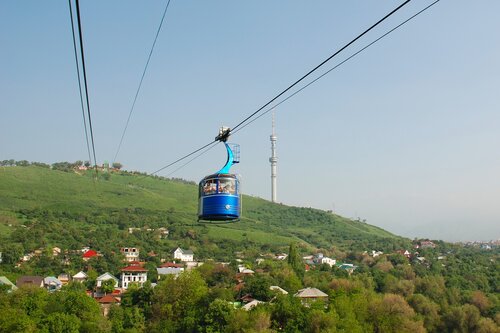
«Фуникулер на гору Кок-Тобе» на Яндекс.Фотках
In order to better look at Almaty, you must climb by cable car to the top of the Kok-Tobe – green hill, from where one can open a magnificent panorama of the Almaty, a garden city.
Near to Almaty. Turgen waterfalls.

«Водопад Медвежий.» на Яндекс.Фотках

«Цветочек аленький» на Яндекс.Фотках

«Кайракский водопад или водопад Бузгуль.» на Яндекс.Фотках

«"Египетская" пирамида» на Яндекс.Фотках
Turgen waterfalls are located in the beautiful valley Turgen Trans-Ili Alatau in the
Almaty, Dostyk Avenue, monument dedicated to Jambyl Jabayev

Посмотреть на Яндекс.Фотках
Almaty history
Prehistoric Almaty
During 1000–900 BCE in the Bronze Age the first farmers and cattle-breeders established settlements on the territory of Almaty.
During the Saka’s period (from 700 BCE to the beginning of the Common Era), these lands were chosen for residence by Saka tribes and later Uisun tribes inhabiting the territory north of the Tian Shan mountain range. The evidences of these times are numerous burial tumuli and ancient settlements, especially giant burial mounds of Saka tsars. The most famous archaeological finds are the Golden man from the Issyk Kurgan, Zhalauly treasure, Kargaly diadem, Zhetysu arts bronze (boilers, lamps and altars). During the period of Saka and uisun governance, Almaty became the early education center.
Middle Ages
The next stage of Almaty evolution is attributed to the Middle Ages (8–10th centuries) and is characterized by city culture development, transfer to a settled way of living, farming and handicraft development, and the emergence of a number of towns and cities in the territory of Zhetysu.
In 10–14th centuries, settlements in the territory of the so called "Big Almaty" became part of the trade routes of the Silk Road. At that time, Almaty became one of the trade, craft and agricultural centers on the Silk Road and possessed an official mint. The city was first mentioned as Almatu in books from the 13th century.
15th–18th centuries
In the 15th–18th centuries, the city was on the way to degradation as trade activities were decreasing on this part of the Silk Road. Notwithstanding, this period was saturated with very important political events that had significant impact on the history of Almaty and Kazakhstan as a whole. It was a period of crucial ethnic and political transformations. The Kazakh state and nation were founded here, close to Almaty.
These lands also witnessed the tragic developments related to the Dzungar intervention and rigorous efforts of the Kazakh to protect their land and preserve independence. In 1730 the Kazakh defeated the Dzungar in the Anyrakay mountains, 70 km to north-west from Almaty. It was a critical moment of the Patriotic War between Kazakhs and Dzungars.
Foundation of Verniy
On 4 February 1854 the modern history of the city began with the strengthening of the Russian piedmont Fort Verniy nearby the Zailiysky Alatau mountain range between Bolshaya and Malaya Almatinka rivers. The construction of the Verniy Fort was almost finished by autumn 1854. It was a fenced pentagon and one of its sides was built along the Malaya Almatinka. Later, wood fence was replaced with the wall of brick with embrasures. Main facilities were erected around the big square for training and parading.[5]
In 1855 the first displaced Kazakh appeared in Verniy. Since 1856, Verniy started accepting Russian peasants. They founded the Bolshaya Almatinskaya Stanitsa (Cossack village) nearby the fortification. The inflow of migrants was increasing and led to construction of the Malaya Almatinskaya Stanitsa and Tatarskaya (Tashkentskaya) sloboda. It was the place of settlement for Tatar mechants and craftsmen.
In 1867 the Verniy Fort was transformed into the town and called Almatinsk. However, the population did not like the new name of the town and soon the town was re-named as Verniy.
According to the First City Plan, the city perimeters were 2 km on the south along Almatinka river, and 3 km on the west. The new city area was divided into residential parts, and the latter — into districts. Three categories of the city buildings were distinguished. Buildings of the first and second categories were two-storied or, at least, one-storied constructions with the high semi-basement. Buildings of categories I and II were erected around and in the center of the city, others — on the outskirts.
On 28 May 1887, at 4 a.m., an earthquake almost totally destroyed Verniy in 11–12 minutes. Brick buildings were mostly damaged. As a result, people were inclined to build up one-storied construction made of wood or adobe.
20th century Almaty
Almaty from the Revolution of 1917 to World War II
In 1921, the joint solemn sitting was summoned for the participation of the representative of government regional and sub-regional institutions, professional trades, the Muslim people to make a decision to assign a new name to Verniy — Alma-Ata.
In 1926, the Council of Labour and Defence approved the construction of the Turkestan-Siberia Railwayrailway that was a crucial element of the republic reconstruction, specifically on the east and southeast of the republic. The Turkestan-Siberia Railway construction was also a decisive economic aspect that foreordained the destiny of Alma-Ata as a capital of Kazakh ASSR. In 1930 the construction of the highway and railway to the Alma-Ata station was completed.
On 2 March 1927, It was the initiative of the Central Executive Committee of the Kazakh Republic to transfer the capital from Kyzyl-Orda to Alma-Ata. The VI Kazakhstani Congress approved this initiative.[6]
On 29 April 1927, it was officially decided on the sitting of the Russian SFSR Committee to transfer the capital of the Kazakh Autonomous Soviet Socialist Republic from Kyzyl-Orda to Alma-Ata.
Besides, the Alma-Ata airport was opened in 1930 and people from the capital of Kazakhstan could fly now from Alma-Ata to Moscow. Alma-Ata became the air gate to Kazakhstan. Transformation of the small town into the capital of the Republic was supplied by the large-scaled construction of new administrative and government facilities and housing. Given the transfer of the capital of Kazakhstan to Alma-Ata, in 1936 the Architecture and Planning Bureau elaborated the General Plan aimed at re-creating Alma-Ata as the new cultural and comfortable capital of Kazakhstan. The Plan was based on the existing rectangular system of districts that would further be strengthened and reconstructed.
Almaty in World War II
During World War II the city territory was changed to a large extent. To organize the home front and concentrate industrial and material resources, the residential stock was compressed to arrange accommodation for 26,000 persons evacuated. Alma-Ata hosted over 30 industrial facilities from the front areas, 8 evacuated hospitals, 15 institutes, universities and technical schools, around 20 cultural institutions, etc. Motion pictureproduction companies from Leningrad, Kiev and Moscow were also evacuated to Alma-Ata.
Owing to self-denying labour, over 52,000 Alma-Ata residents were awarded. 48 residents were granted the title of Hero of The Soviet Union. Threerifle divisions were raised in Alma-Ata , including the well-known 8th Panfilov’s division, along with 2 rifle battalions and 3 aviation regiments that were raised on the bases of the air club of Alma-Ata.
Almaty from 1945 to 2000
From 1966 to 1971, 1,400,000 square meters of public and cooperative housing were put into operation. Annually, around 300,000 square meters of dwellings were under construction. It was the period of constructing earthquake-proof multi-storied buildings. Construction unification and type-design practice diversified architectural forms. At that time were constructed lots of schools, hospitals, cultural and entertainment facilities, including the Lenin’s Palace, Kazakhstan Hotel, sport complex “Medeo”, etc.
The Medeu Dam, designed to protect the city of Almaty and the Medeo skating rink from catastrophic mudflows, was built in 1966 and reinforced a number of times in the 1960s and 1970s.
The supersonic transport Tupolev Tu-144 went into service on 26 December 1975, flying mail and freight between Moscow and Alma-Ata in preparation for passenger services, which commenced in November 1977. The Aeroflot flight on 1 June 1978 was the Tu-144's 55th and last scheduled passenger service.
Since 1981, the underground Almaty Metro construction project has been developed.
On 16 December 1986 Jeltoksan riot took place in response to General Secretary Mikhail Gorbachev's dismissal of Dinmukhamed Kunayev.
In 1997 the President of the Republic of Kazakhstan Nursultan Nazarbayev approved the Decree to transfer the capital from Almaty to Astana.[7]



